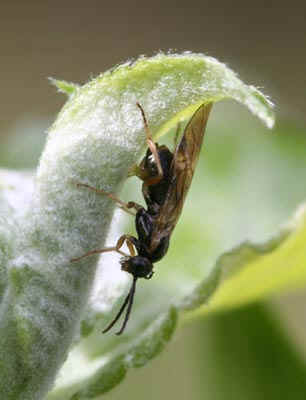
Observed Ichneumonid parasitoids of Nematus pavidus
Illustrated observations from 2006 to 2009
Background
Symphyta, or Sawflies, are members of the hymenoptera. Females lay their eggs on particular plants (the plant chosen depends on the species of Sawfly) using their modified ovipositor, or saw, to prepare the leaves. The larvae feed extensively on that selected vegetation until they are fully-grown and ready to pupate (or in some cases, aestivate).
Nematus pavidus is a Sawfly dependant on Salix sp.
Ichneumonids are also members of the hymenoptera, and are parasitic on insect larvae. The female uses her ovipositor to inject an egg or eggs into the host larva. These parasitoids develop inside the host larva and consume it before pupation. Many ichneumonids are parasitic on lepidopterous larvae, others on dipterous larvae, still others on Sawfly larvae, and some on the larvae of other ichneumonids. This latter group are known as paraparasites and hyperparasites.
This paper presents the current results of an ongoing study into parasitoids and paraparasitoids of larvae of the Sawfly Nematus pavidus as observed at Raphoe, Co. Donegal, Ireland between 2006 and 2009.
Environment
The Salix specimens observed are Salix cinerea on a grass verge bordering a narrow roadway, and backing onto pasture bordered by Gorse and Hawthorn. The Salix are pruned to the ground in winter every 2 years, so the growth is very vigorous and the leaves are much larger than those usually encountered - about 10 cm long.
Observations
Oviposition and Saw
Female Sawfly ovipositing on Salix:

Close-up of the saw:
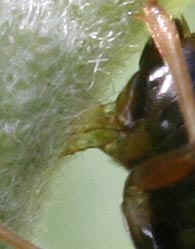
Eggs
Eggs are deposited in large batches of around 50-80. Notice the anchoring slits cut into the leaf:
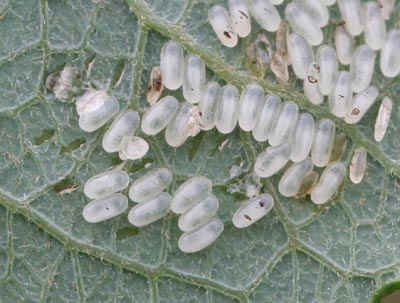
The larvae hatch and go through a number of instars, with populations of different instars being present at the same time, due to successional laying, probably by different females. This image shows - on a single leaf - (clockwise from 12) newly-hatched larvae, mature eggs (1 o'clock), instar-2 larvae (large hole, 6 o'clock), and a hatching batch at 10 o'clock.

Larvae
In the following image, at least 3 instars are shown:
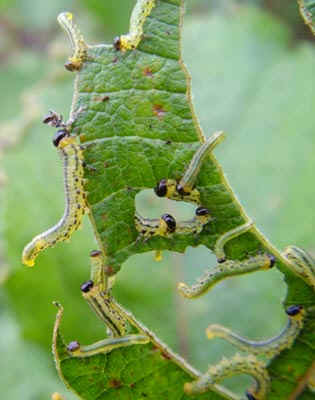 .
.
The larvae abruptly and swiftly adopt a defensive, S-shaped posture when disturbed:
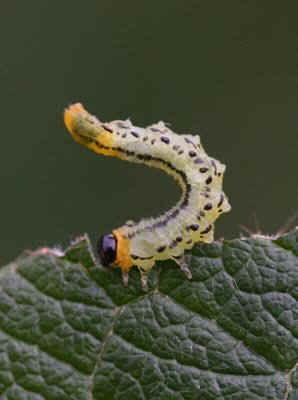
This is thought to be a mechanism to avoid parasitisation, and the success of this mechanism was frequently observed, with both parasitoids and hyperparasitoids being physically repelled by the sudden change of posture.
Primary parasitisation
Campodorus sp. females were observed ovipositing from the underside of the leaf, flexing the elongated abdomen.The Campodorus appears to be protecting itself from the Nematus pavidus larva's protection reflex.
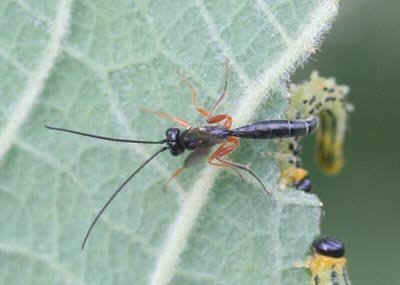
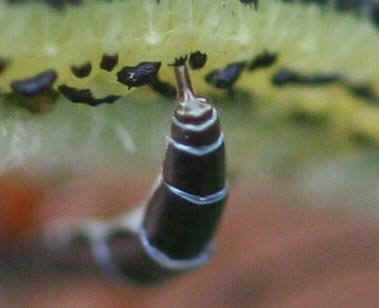
On very few occasions, the Campodorus oviposited from the same side of the leaf:
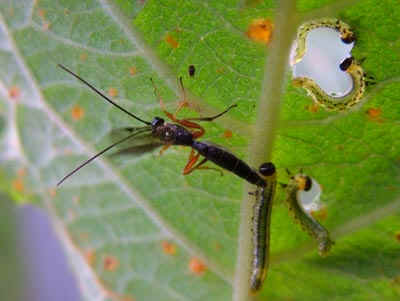
Secondary parasitisation
The hyperparasite is Mesochorus sp. These lay their eggs in larvae which have already been parasitised by other ichneumonids (or, indeed Tachinids - parasitic flies). Two or three days after the initial parasitisation, Mesochorus were observed testing the defensive reflex of the larvae, by rapidly beating their front legs down on the leaf at either side of the larva's head. It is presumed that parasitised larvae have the defensive reflex reduced in some way by the presence of the egg of the primary parasite. This is both an advantage and a disadvantage to the Campodorus: it enables the Campodorus to identify already parasitised larvae and avoid depositing an egg in an already-parasitised larva, but it also allows the Mesochorus to identify the presence of the primary parasite.
This image shows the Mesochorus in the process of ovipositing from a straddle position:
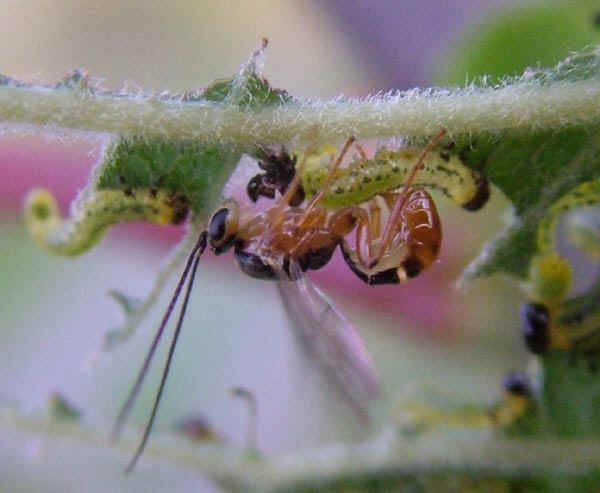
A rear-view image of the Mesochorus ovipositing:
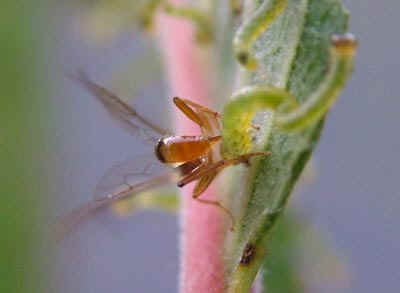
The hyperparasitoid was observed laying multiple eggs into the same host larva. This sequence shows 4 eggs being injected:
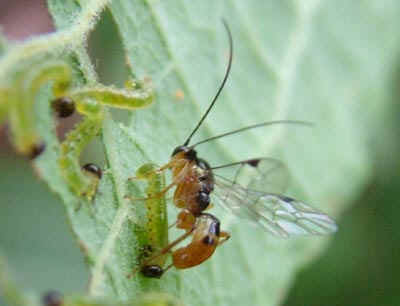
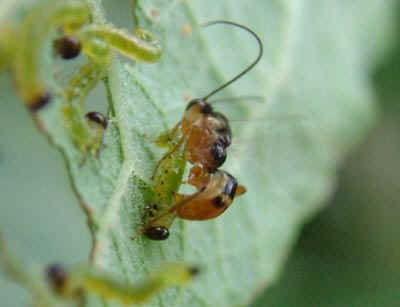

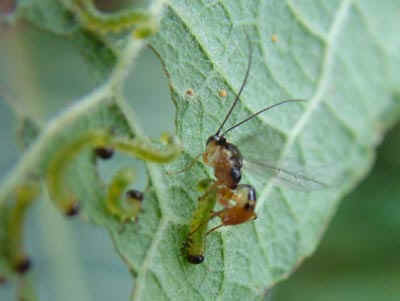
Note that in the above sequence, the larva does not adopt the defensive position.
The conclusion is that since the hyperparasitoid is only slightly smaller than the primary parasitoid, then only one egg must be viable in each larva (there is only so much protein available to be consumed): 75% of the eggs will miss the target and be wasted. So the multiple egg-laying indicates that the precise location of the target of the hyperparasitoid must be difficult (or impossible) to determine, so multiple eggs are deposited to give one the chance to find its target. This wastage of eggs is unusual in parasitisation: by observation, ichneumonids are usually extremely accurate when finding hosts and injecting eggs.
The following image attempts to give some scale to the matter at hand. The hyperparasite is shown just to the right of centre of the Salix leaf.
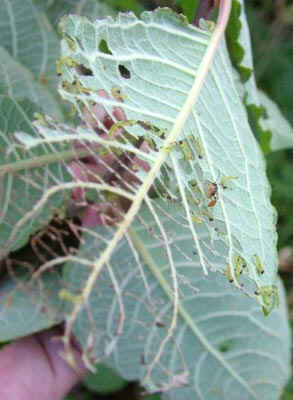
Some larvae adopt a hanging posture, presumably to avoid the ichneumonid. The ploy doesn't always work:
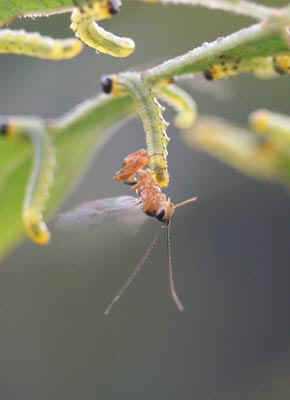
Future
1) Solidify and tidy up terminology - parasite vs parasitoid vs hyperparasite vs paraparasite, etc.
2) At present, identifications have been performed as far as is possible from photographs. Specimens will be captured this year (2009), and hopefully we will then have identification to species.
3) It is currently unknown if the hyperparasite targets the egg or larva of the primary parasite, although the short timescale (2-3 days from initial parasitisation) would suggest that the egg is the target. Update: September 2009. The timing was confirmed in September 2009 as 2 days between primary and secondary parasitisation, both on the same batch. The hyperparasite must be targetting the egg of the primary parasite. This would explain the multiple injections made by the Mesochorus: the Campodorus egg will be difficult to locate. It also makes sense in terms of the Campodorus larva. If it hatched early it would have to consume the sawfly larva before the sawfly larva had reached full size, and this clearly doesn't happen. So, again, the Campodorus egg makes more sense than the Campodorus larva as a target.
4) Publication (where?)
© Stuart Dunlop 2006 - 2009